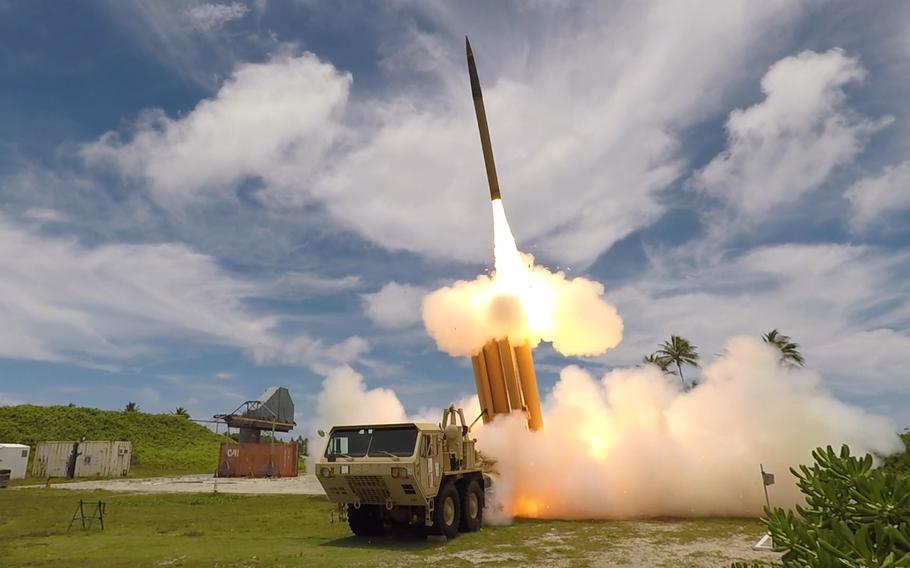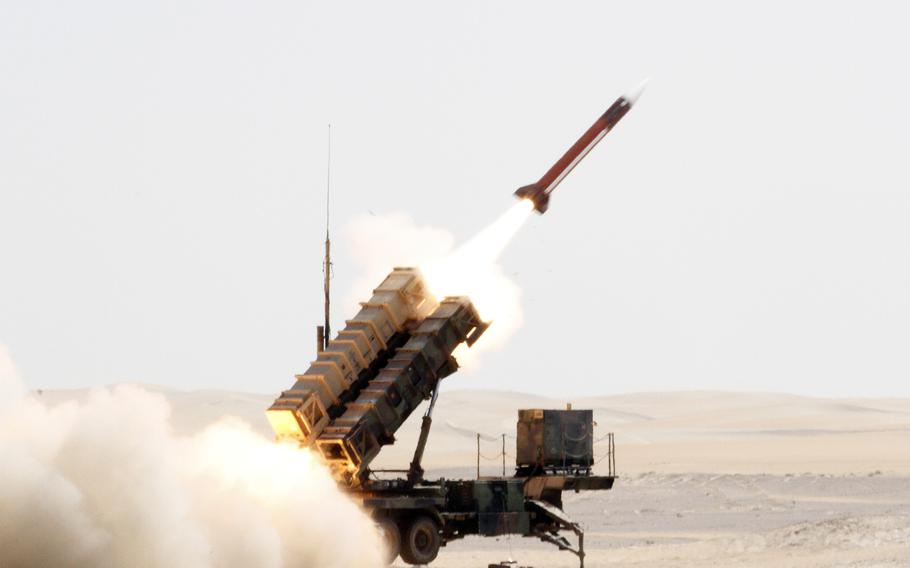
A Terminal High Altitude Area Defense interceptor is launched from the Reagan Test Site on the Kwajalein atoll in 2019. The Pentagon is ramping up THAAD procurement after expending nearly a quarter of its stockpile last month against Iranian missiles. (Missile Defense Agency)
The Pentagon is ramping up missile defense production after the U.S. military expended nearly a quarter of its high-altitude interceptor arsenal during Iran’s attacks on Israel last month.
This week, the Missile Defense Agency authorized spending an extra $2 billion on an existing contract with Lockheed Martin to deliver more high-altitude interceptors over the next four years, in a bid to strengthen one of the military’s marquee missile defense systems.
The extra $2 billion is a considerable investment in the Terminal High Altitude Area Defense system but comes after years of flagging production that could leave the U.S. unprepared to handle future conflicts, analysts say.
“It’s a recognition of reality,” Bradley Bowman, senior director of the Center on Military and Political Power at the Foundation for Defense of Democracies, said about the order for additional interceptors. “I’m not happy that we’re waking up at this late hour, but I’m very happy that we’re waking up.”
The contract modification follows the U.S. launch of more than 150 THAAD interceptors from two systems during a 12-day conflict with Iran — nearly 25% of all interceptors ever purchased by the Pentagon, according to a report by The Wall Street Journal, citing U.S. officials.
The rapid depletion has reignited long-standing concerns about readiness for a potential conflict with a major power and highlighted the need to accelerate missile procurement at the Pentagon.

Soldiers launch a Patriot missile at an airborne target during a live-fire exercise at an undisclosed location. The Army has requested $300 million to modernize Patriot interceptors. (Kyle Fisch/U.S. Army)
“If we’re struggling to deal with threats from Iran, how do we think we’re going to do… against China?” Bowman said. “That’s going to make Iran look like the junior varsity.”
Neither the contractor nor the agency disclosed the quantity of interceptors included in the contract update. Lockheed Martin said it has delivered 900 THAAD interceptors to date, including foreign orders.
“We remain committed to innovation and investment in interceptor production as global events continue to highlight the importance of providing unparalleled protection for populations and infrastructure,” Dawn Golightly, vice president of upper tier integrated air and missile defense at Lockheed Martin, said in a statement.
At an estimated cost of $12.7 million apiece, according to recent budget estimates from the MDA, the extra funding will almost certainly be enough to fully replace last month’s THAAD launches.
“(An amount of) $2 billion gets you to at least a replacement level of interceptors that were expended over the course of the 12 days,” said Wes Rumbaugh, a fellow in the Missile Defense Project at the Center for Strategic and International Studies.
In response to questions about missile defense stockpiles, Defense Department spokeswoman Kingsley Wilson said “the U.S. military is the strongest it has ever been and has everything it needs to conduct any mission anywhere, anytime, all around the world.”
“If you need further proof, look no further than Operation Midnight Hammer and the total obliteration of Iran’s nuclear ambitions,” Wilson added.
Each THAAD battery consists of about 90 soldiers, six truck-mounted launchers and 48 interceptors, backed by radar that tracks incoming short- and medium-range ballistic missiles, according to the Missile Defense Agency.
At least half of the Army’s eight THAAD batteries are deployed, including two in the Middle East, the Congressional Research Service said in a report this month.
THAAD interceptor purchases peaked in 2018 and 2019, when the U.S. secured 109 and 110 missiles, respectively, according to Rumbaugh’s analysis. Since then, production has dropped significantly, with Lockheed Martin delivering just 11 interceptors in 2024.
The dropoff suggests that the Pentagon felt comfortable with its stockpile and was focused on funding other priorities, Rumbaugh said.
But the recent pace of operations, including those against the Houthi rebels in Yemen, has driven a reassessment.
That increased urgency is a positive sign, Bowman said, but he added that manufacturers can produce far more than the 37 interceptors Congress asked for in 2026.
Bowman estimates that the industrial base could produce three to four times more THAAD missiles than lawmakers are requesting.
It’s not just THAADs that are facing a shortfall. The Army wants to bolster its Patriot systems, the same ones that fended off Iranian missiles aimed at Al Udeid Air Base in Qatar last month.
Industry can produce 500 Patriot PAC-3 missiles per year, with that number set to rise to 650 by 2027, according to FDD. The Trump administration has requested 341 PAC-3s in next year’s budget, with additional missiles going to foreign militaries.
The Army has also requested $300 million to modernize the PAC-3 line in its annual unfunded priorities list.
Concerns also extend to the Navy. The Wall Street Journal reported that naval destroyers fired about 80 SM-3 interceptors during the Iranian conflict.
The Missile Defense Agency earlier this year inked a $1 billion contract with manufacturer Raytheon for 55 more SM-3s to be delivered by spring 2031.
“This is a problem endemic to, essentially, the entire U.S. military air missile defense enterprise,” Bowman said. “In almost every case, we do not have the capacity that we need.”
The broader issue reflects systemic problems with how the military develops and acquires weapons. Critics say the system is bogged down by bureaucracy, making it difficult and expensive to deliver arms quickly in a crisis.
A decline in missile procurement has discouraged contractors from expanding their production capacity, Bowman said.
Vice Adm. Brad Cooper, the incoming head of U.S. Central Command, told lawmakers at a hearing last month that munitions stockpiles and magazine depth were among his top concerns.
He said he supports recent efforts to cut red tape and wants to see the military leverage the tech sector’s capabilities.
“I think we need to move with a sense of urgency,” he said.